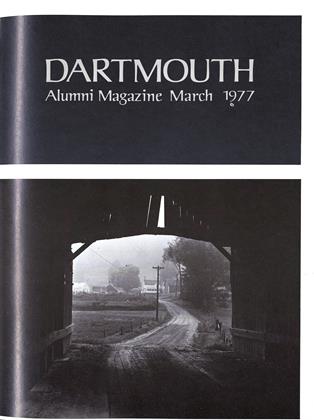THE landscape painter necessarily depicts his world, which filters through the artistic eye in an intensely personal prism of light and shadow, detail and form, symbol and meaning. This portfolio of recent works by Thomas George '40, Peter Holbrook '61, and Douglas Wilson '75 illustrates how each artist renders the natural world of his own experience - the mountains and valleys of China (George) and the flat pools and gnarled shapes of California (Holbrook and Wilson).
Thomas George's work dates from the fall of last year, when he made his second trip to the People's Republic of China. "My eye was searching for mass and essence," he says. "To achieve a surface likeness is one thing.. To extract the internal structure and record the exciting power of this part of China is quite another." Holbrook and Wilson have sought out the pastoral world closer to home, but it is no less "new" to the viewer. One takes a bow to the surrealists, the other to 19th century traditionalists.
The three are professional artists. George's work is on exhibit at the National Collection of Fine Arts, Renwick Gallery, Smithsonian Institution through April 10; Holbrook's paintings are at the ADI Gallery in San Francisco; and Wilson just completed a month-long show at the Worcester Museum of Art in Worcester, Massachusetts.
ThomasGeorge
PeterHolbrook
Douglas Wilson
Peter Holbrook, Brush Pile
Thomas George, Reed Flute Cave Park, Kweilin
Yang Ti Valley, Kwangsi
Grinding Stone Mountain, Kweilin
Cliff Face, Kwangsi
Big Market Village on the River Li, Kwangsi
Terraced Valley, Changsha
Oak Stump.
Cave on the Yellowstone
Redwood Creek - Pepperwoods
Eubank Madrone #3
Tan Oak Roots
Marsh Harbor at Dawn
Caught in Sunlight
Deep in the Date Grove
A Palm's Heart
Coastal Cliff Mirrored
Thomas George"I was in the People's Republic for 35 days and during this time I made many contacts with the Chinese people. One in particular I will always remember. One day I was sitting on the raised bank of a rice field painting my favorite mountain in Kweilin, appropriately .named 'Best Mountain.' My translator and friend, Chen Gin Han, hovered nearby as usual, keeping the curious away. When I had finished working, Mr. Chen came over with a peasant farmer who wanted to see what I had done. The old man told us that he enjoyed art and was well acquainted with traditional Chinese painting. He studied my work for a while and then remarked, 'You know, I've never in all my life seen a picture like this, yet I like what the artist has done. He has made only a few lines but they are the important ones. Now I can put in the rest myself." Smithsonian catalogue
Peter Holbrook "I have attempted, especially in the last seven or eight years, to make paintings that require no special knowledge of art or the artist, and need no critical interpretation for their understanding. They belong to no school or movement and are as empty of ego-content as I can make them. Painting is above all a non-verbal communication, and even the best critical evaluation tends to diminish the work. Since these pieces are in color, much is lost by reproducing them in black and white, but perhaps this will serve to whet someone's interest in seeing the originals. "
Douglas Wilson "At this point in my career my most adamant concern is one which I expect to be predominant throughout my career learning how to paint. I am interested in conveying my subject with as much simplicity and economy as possible, without obscuring the clarity of my subject. My approach to learning how to paint is not wholly consistent with the ideas and approaches of most artists working in the 20th century. It seems to me that artists today are most concerned with the expression of an idea or with expression itself. The difficulty that arises from the emphasis on idea and expression is that it de-emphasizes or bypasses the technical training (characteristic of the pre- Impressionist Academe) which is the area deserving urgent attention from the majority of seriously aspiring young artists. This stage of technical development is particularly challenging for me because I have chosen two of America's most technically adept painters as models: Winslow Homer and John Singer Sargent.... I'm drawn to San Francisco for the same reason the world seems to be it's a very beautiful city. With all due respect to romance, I see little sense in enduring a stinky Soho loft."
 View Full Issue
View Full Issue
More From This Issue
-
 Feature
FeatureDinner for the Colonel
March 1977 By BRAVIG IMBS -
 Feature
FeatureWomen and Admissions: All Deliberate-speed Ahead
March 1977 -
 Feature
FeatureSleep-filled Days, Gambling Nights
March 1977 By BRAD W. BRINEGAR -
 Article
ArticleRambling with Melancholy
March 1977 By JACK DEGANGE -
 Article
ArticleA Versatile, Admirable Teacher With "Every Feature of a Drill Sergeant'(sic)
March 1977 By S.G. -
 Class Notes
Class Notes1974
March 1977 By STEPHEN D. SEVERSON, JACK E. THOMAS JR.
Features
-
 Feature
FeatureSports Style-Setter
FEBRUARY 1967 -
 Feature
FeatureStately Pleasure-Domes
MAY 1990 -
 Feature
FeatureNotes Towards a "Whole Life Catalog"
MARCH 1973 By ALAN T. GAYLORD, DIRECTOR -
 FEATURE
FEATUREAmerican Odyssey
JULY | AUGUST 2019 By JAMES D. WALSH -
 Feature
FeatureAlumni News
Sep - Oct By Natalia Wrobel ’11, Natalia Wrobel ’11 -
 Feature
FeatureNotebook
NOVEMBER | DECEMBER 2015 By SHERMAN JOHN








